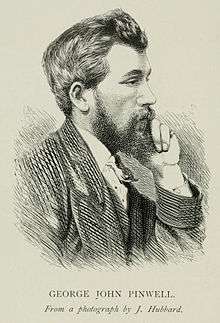George John Pinwell
George John Pinwell RWS (London 26 December 1842 – 8 September 1875 London), was a British illustrator and watercolourist.[1]

Biography
Pinwell received his art education at educated at St. Martin's Lane Academy and Heatherley's Academy. He belonged to the small group of watercolour painters which included Frederick Walker and Arthur Boyd Houghton, whose style came from drawing on wood for book-illustration. His career was cut short by an early death.
He came from a poor background, but in 1862 he entered Heatherley's studio and there obtained his art education. His earliest drawings appeared in Littiput Levée. He did a little work for the periodical Fun and executed several designs for the silversmiths Elkington's. He worked for Josiah Wood Whymper and through him met J W North and Fred Walker.[2] In 1863 his first drawing appeared in Once a Week and from that time his work was in constant demand. There were many of his compositions in Good Words, The Sunday Magazine, The Quiver and London Society, and he subsequently illustrated for the Dalziel Brothers' editions of Oliver Goldsmith, of Jean Ingelow's poems, Robert Buchanan's Ballads of the Affections, and the Arabian Nights. Best-known were two scenes from the Pied Piper of Hamelin, the Troth of Gilbert Becket, the Saracen Maiden the legendary mother of Thomas Becket, Out of Tune (or The Old Cross), A Seat in St James's Park (1869; Art Gallery of New South Wales, Sydney) and The Elixir of Life.
In 1874 Pinwell fell seriously ill and went to Africa for the winter. He painted three major watercolours at Tangier, which were among his last works exhibited at the Royal Watercolour Society in 1875, but his strength gradually broke down and he returned to die in his wife's arms. Pinwell contributed watercolours to the Dudley Gallery from 1865 onwards, and in 1869 was elected associate of the Royal Watercolour Society and then full member in 1871.[3] To this gallery he contributed fifty-nine works. He died in London, and is buried at Highgate Cemetery. A posthumous exhibition of his works was held in 21 February – 11 March 1876 at 168 New Bond Street.
References

Footnotes
- . Encyclopædia Britannica. 21 (11th ed.). 1911. p. 631.
- WILLIAMSON, GEORGE C. (1900). GEORGE J. PINWELL AND HIS WORKS. London: GEORGE BELL and SONS.
- 'Obituary: George John Pinwell', The Art Journal, December 1875, pp. 365–66 (366).
Further reading
- George Charles Williamson, George J. Pinwell and his works (London: George Bell & Sons, 1900).
- Pamela White Trimpe, George John Pinwell: A Victorian Artist and Illustrator (New York: Peter Lang Publishing, 2001)
- Donato Esposito, 'George John Pinwell (1842–1875)', in Frederick Walker and the Idyllists (London: Lund Humphries, 2017), pp. 61–89.
External links
- Works by George John Pinwell at Project Gutenberg
- George Pinwell ("The idyllists" - southwilts.com)
- George Pinwell (Victorian web)